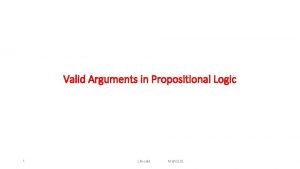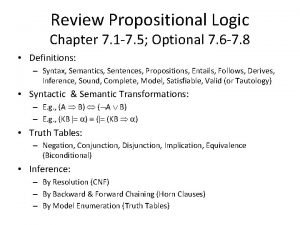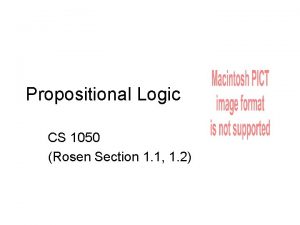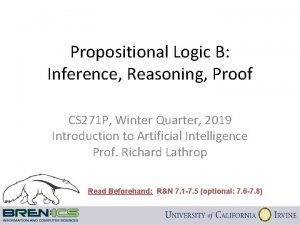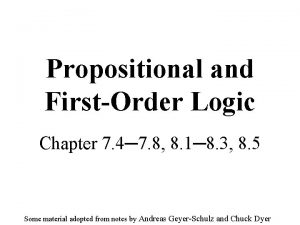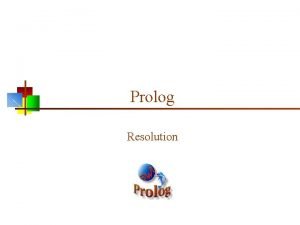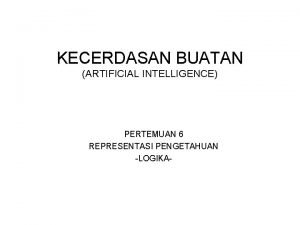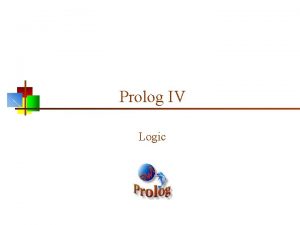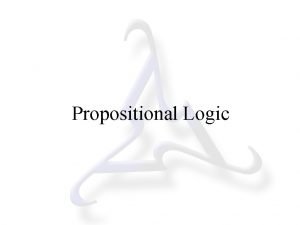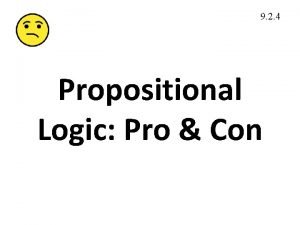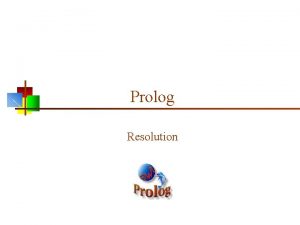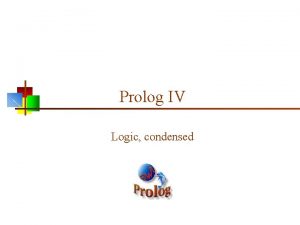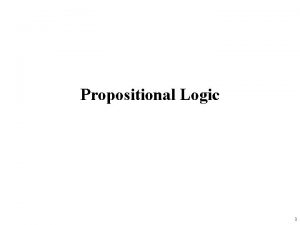9 2 4 Propositional Logic Pro Con Propositional










- Slides: 10

9. 2. 4 Propositional Logic: Pro & Con

Propositional logic: pro and con • Advantages – Simple KR language good for many problems – Lays foundation for higher logics (e. g. , FOL) – Reasoning is decidable, though NP complete; efficient techniques exist for many problems • Disadvantages – Not expressive enough for most problems – Even when it is, it can very “un-concise”

PL is a weak KR language • Hard to identify individuals (e. g. , Mary, 3) • Can’t directly represent properties of individuals or relations between them (e. g. , “Bill age 24”) • Generalizations, patterns, regularities hard to represent (e. g. , “all triangles have 3 sides”) • First-Order Logic (FOL) represents this information via relations, variables & quantifiers, e. g. , • John loves Mary: loves(John, Mary) • Every elephant is gray: x (elephant(x) → gray(x)) • There is a black swan: x (swan(X) ^ black(X))

Hunt the Wumpus domain • Some atomic propositions: A 12 = agent is in call (1, 2) S 12 = There’s a stench in cell (1, 2) B 34 = There’s a breeze in cell (3, 4) W 22 = Wumpus is in cell (2, 2) V 11 = We’ve visited cell (1, 1) OK 11 = cell (1, 1) is safe … • Some rules: S 22 W 12 W 23 W 32 W 21 B 22 P 12 P 23 P 32 P 21 W 22 S 12 S 23 S 32 W 21 W 22 W 11 W 21 … W 44 A 22 V 22 A 22 W 11 W 21 … W 44 V 22 OK 22 If there’s no stench in cell 2, 2 then the Wumpus isn’t in cell 21, 23 32 or 21

Hunt the Wumpus domain • Eight symbols for each cell, i. e. : A 11, B 11, G 11, OK 11, P 11, S 11, V 11, W 11 • Lack of variables requires giving similar rules for each cell! • Ten rules (I think) for each A 11 … V 11 … P 11 … W 11 … S 11 … B 11 … • 8 symbols for 16 cells => 128 symbols • 2128 possible models • Must do better than brute force

After third move • We can prove that the Wumpus is in (1, 3) using these four rules • See R&N section 7. 5 (R 1) S 11 W 11 W 12 W 21 (R 2) S 21 W 11 W 22 W 31 (R 3) S 12 W 11 W 12 W 22 W 13 (R 4) S 12 W 13 W 12 W 22 W 11

Proving W 13: Wumpus is in cell 1, 3 Apply MP with S 11 and R 1: (R 1) S 11 W 11 W 12 W 21 (R 2) S 21 W 11 W 22 W 31 (R 3) S 12 W 11 W 12 W 22 W 13 Apply AE, yielding three sentences: (R 4) S 12 W 13 W 12 W 22 W 11, W 12, W 21 Apply MP to ~S 21 and R 2, then apply AE: W 22, W 21, W 31 Apply MP to S 12 and R 4 to obtain: W 13 W 12 W 22 W 11 Apply UR on (W 13 W 12 W 22 W 11) and W 11: W 13 W 12 W 22 Apply UR with (W 13 W 12 W 22) and W 22: Rule Abbreviation W 13 W 12 MP: modes ponens Apply UR with (W 13 W 12) and W 12: AE: and elimination W 13 R: unit resolution QED

Propositional Wumpus problems • Lack of variables prevents general rules, e. g. : • x, y V(x, y) → OK(x, y) • x, y S(x, y) → W(x-1, y) W(x+1, y) … • Change of KB over time difficult to represent – In classical logic; a fact is true or false for all time – A standard technique is to index dynamic facts with the time when they’re true • A(1, 1, 0) # agent was in cell 1, 1 at time 0 • A(2, 1, 1) # agent was in cell 2, 1 at time 1 – Thus we have a separate KB for every time point

Propositional logic summary • Inference: deriving new sentences from old – Sound inference derives true conclusions given true premises – Complete inference derives all true conclusions from premises • Different logics make different commitments about what world is made of and kinds of beliefs we can have • Propositional logic commits only to existence of facts that may or may not be the case – Simple syntax & semantics illustrates inference process – Sound, complete and fast proof procedures – It can be impractical or cumbersome for many worlds

Fin



